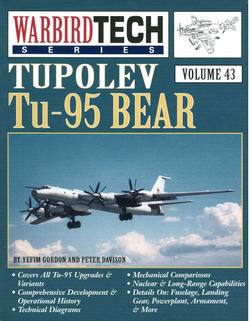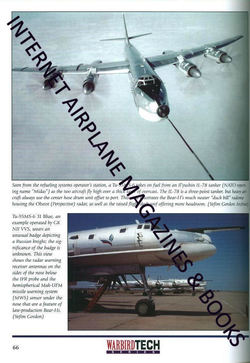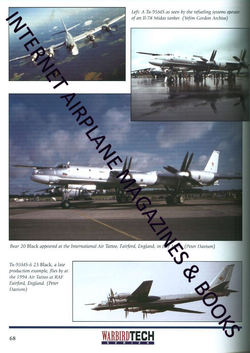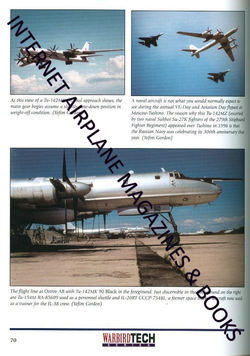----------------------------------------------------------------------------------------
Additional information from
Internet Encyclopedia
The Tupolev Tu-95 (NATO
reporting name: "Bear") is a large, four-engine turboprop-powered
strategic bomber and missile platform. First flown in 1952, the Tu-95 entered
service with the Soviet Union in 1956 and is expected to serve the Russian
Aerospace Forces until at least 2040. A development of the bomber for maritime
patrol is designated Tu-142, while a passenger airliner derivative was called
Tu-114.
The aircraft has four Kuznetsov
NK-12 engines with contra-rotating propellers. It is the only propeller-powered
strategic bomber still in operational use today. The Tu-95 is one of the
loudest military aircraft, particularly because the tips of the propeller
blades move faster than the speed of sound. Its distinctive swept-back wings
are set at an angle of 35°. The Tu-95 is unique as a propeller-driven aircraft
with swept wings that has been built in large numbers.
The design bureau, led by Andrei
Tupolev, designed the Soviet Union's first intercontinental bomber, the 1949
Tu-85, a scaled-up version of the Tu-4, a Boeing B-29 Superfortress copy.
A new requirement was issued to
both Tupolev and Myasishchev design bureaus in 1950: the proposed bomber had to
have an un-refueled range of 8,000 km (4,970 mi)—far enough to threaten key
targets in the United States. Other goals included the ability to carry an 11,000
kg (24,200 pounds) load over the target.
Tupolev was faced with selecting
a suitable type of powerplant: the Tu-4 showed that piston engines were not
powerful enough for such a large aircraft, and the AM-3 jet engines for the
proposed T-4 intercontinental jet bomber used too much fuel to give the
required range. Turboprop engines were more powerful than piston engines and
gave better range than the turbojets available at the time, and gave a top
speed between the two. Turboprops were also initially selected for the Boeing
B-52 Stratofortress to meet its long range requirement, and for the British
long-range transport aircraft, the Saunders-Roe Princess, the Bristol Brabazon
and the Bristol Britannia.
Tupolev proposed a turboprop
installation and Tu-95 design with this configuration was officially approved
by the government on 11 July 1951. It used four Kuznetsov coupled turboprops,
each fitted with two contra-rotating propellers with four blades each, with a
nominal 8,948 kW (12,000 effective shaft horse power [eshp]) power rating. The
engine, advanced for its time, was designed by a German team of ex-Junkers
prisoner-engineers under Ferdinand Brandner. The fuselage was conventional with
a mid-mounted wing with 35 degrees of sweep, an angle which ensured that the
main wing spar passed through the fuselage in front of the bomb bay.
Retractable tricycle landing gear was fitted, with all three gear strut units
retracting rearwards, with the main gear units retracting rearwards into
extensions of the inner engine nacelles.
The Tu-95/I, with 2TV-2F
engines, first flew in November 1952 with test pilot Alexey Perelet at the
controls.[8] After six months of test flights this aircraft suffered a
propeller gearbox failure and crashed, killing Perelet. The second aircraft,
Tu-95/II used four 12,000 eshp Kuznetsov NK-12 turboprops which proved more
reliable than the coupled 2TV-2F. After a successful flight testing phase,
series production of the Tu-95 started in January 1956.
For a long time, the Tu-95 was
known to U.S./NATO intelligence as the Tu-20. While this was the original
Soviet Air Force designation for the aircraft, by the time it was being
supplied to operational units it was already better known under the Tu-95
designation used internally by Tupolev, and the Tu-20 designation quickly fell
out of use in the USSR. Since the Tu-20 designation was used on many documents
acquired by U.S. intelligence agents, the name continued to be used outside the
Soviet Union.
Initially the United States
Department of Defense evaluated the Tu-95 as having a maximum speed of 644 km/h
(400 mph) with a range of 12,500 km (7,800 mi). These numbers had to be revised
upward numerous times.
The Tu-95RT variant in
particular was a veritable icon of the Cold War as it performed a maritime
surveillance and targeting mission for other aircraft, surface ships and
submarines. It was identifiable by a large bulge under the fuselage, which
reportedly housed a radar antenna that was used to search for and detect
surface ships.
A series of nuclear surface
tests were carried out by the Soviet Union in the early to mid 1960s. On October
30, 1961 a modified Tu-95 carried and dropped the AN602 device named Tsar
Bomba, which was the most powerful thermonuclear device ever detonated. Video
footage of that particular test exists since the event was filmed for
documentation purposes. The footage shows the specially adapted Tu-95V plane –
painted with anti-flash white on its ventral surfaces – taking off carrying the
bomb, in-flight scenes of the interior and exterior of the aircraft, and the
detonation. The bomb was attached underneath the aircraft, which carried the
weapon semi-externally since it could not be carried inside a standard Tu-95's
bomb-bay, similar to the way the B.1 Special version of the Avro Lancaster did
with the ten-tonne Grand Slam "earthquake bomb". Along with the Tsar
Bomba, the Tu-95 proved to be a versatile bomber that would deliver the RDS-4
Tatyana (a fission bomb with a yield of forty-two kilotons), RDS-6S
thermonuclear bomb, the RDS-37 2.9-megaton thermonuclear bomb, and the RP-30-32
200-kiloton bomb.
The early versions of this
bomber lacked comfort for their crews. They had a dank and dingy interior and
there was neither a toilet nor a galley in the aircraft. Though the living
conditions on the bomber were unsatisfactory, the crews would often take two
10-hour mission trips a week to ensure combat readiness. This gave an annual
total of around 1,200 flight hours.
The bomber had the best crews
available due to the nature of their mission. They would undertake frequent
missions into the Arctic to practice transpolar strikes against the United
States. Unlike their American counterparts they never flew their missions carrying
nuclear weapons. This hindered their mission readiness due to the fact that
live ammunition had to come from special bunkers on the bases and loaded into
the aircraft from the servicing trench below the bomb bay, a process that could
take two hours.
Tu-95/1
The first prototype powered by
Kuznetsov 2TV-2F coupled turboprop engines.
Tu-95/2
The second prototype powered by
Kuznetsov NK-12 turboprops.
Tu-95
Basic variant of the long-range
strategic bomber and the only model of the aircraft never fitted with a nose
refuelling probe. Known to NATO as the Bear-A.
Tu-95K
Experimental version for
air-dropping a MiG-19 SM-20 jet aircraft.
Tu-95K22
Conversions of the older Bear
bombers, reconfigured to carry the Raduga Kh-22 missile and incorporating
modern avionics. Known to NATO as the Bear-G.
Tu-95K/Tu-95KD
Designed to carry the Kh-20
air-to-surface missile. The Tu-95KD aircraft were the first to be outfitted
with nose probes. Known to NATO as the Bear-B.
Tu-95KM
Modified and upgraded versions
of the Tu-95K, most notable for their enhanced reconnaissance systems. These
were in turn converted into the Bear-G configuration. Known to NATO as the
Bear-C.
Tu-95LAL
Experimental nuclear-powered
aircraft project.
Tu-95M
Modification of the serial Tu-95
with the NK-12M engines. 19 were built.
Tu-95M-55
Missile carrier.
Tu-95MR
Bear-A modified for
photo-reconnaissance and produced for Naval Aviation. Known to NATO as the
Bear-E.
Tu-95MS/Tu-95MS6/Tu-95MS16
Completely new cruise missile
carrier platform based on the Tu-142 airframe. This variant became the launch
platform of the Raduga Kh-55 cruise missile and put into serial production in
1981.[48] Known to NATO as the Bear-H and was referred to by the U.S. military
as a Tu-142 for some time in the 1980s before its true designation became
known. Currently being modernized to carry the Kh-101/102 stealth cruise
missiles. 21 aircraft have been modernized as of April 2019.
Tu-95MS6
Capable of carrying six Kh-55,
Kh-55SM or Kh-555 cruise missiles on a rotary launcher in the aircraft's
weapons bay. 32 were built.
Tu-95MS16
Fitted with four underwing
pylons in addition to the rotary launcher in the fuselage, giving a maximum
load of 16 Kh-55s or 14 Kh-55SMs. 56 were built.
Tu-95MSM
Modernization of the
"Tu-95MS16" bombers, equipped with the new Novella-NV1.021 radar,
SOI-021 information display system, Meteor-NM2 airborne defense complex and
upgraded Kuznetsov NK-12MPM turboprop engines. First flight scheduled for end
of 2019.
Tu-95N
Experimental version for
air-dropping an RS ramjet powered aircraft.
Tu-95RTs
Variant of the basic Bear-A
configuration, redesigned for maritime reconnaissance and targeting as well as
electronic intelligence for service in the Soviet Naval Aviation. Known to NATO
as the Bear-D.
Tu-95U
Training variant, modified from
surviving Bear-As but now all have been retired. Known to NATO as the Bear-T.
Tu-95V
Special carrier aircraft to
test-drop the largest thermonuclear weapon ever designed, the Tsar Bomba.
Tu-96
Long-range intercontinental
high-altitude strategic bomber prototype, designed to climb up to 16,000–17,000
m. It was a high-altitude version of the Tupolev Tu-95 aircraft with
high-altitude augmented turboprop TV-16 engines and with a new, enlarged-area
wing. Plant tests of the aircraft were performed with non-high altitude TV-12
engines in 1955–1956.














